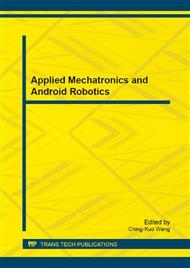p.84
p.88
p.92
p.96
p.100
p.104
p.108
p.112
p.116
Self-Tuning Fuzzy Controller Design for a Switched Reluctance Motor Drive System
Abstract:
This study adopts the fuzzy control theory to design a self-tuning fuzzy controller (STFC), which allows adjustment to overcome the controller design difficulty caused by switched reluctance motor (SRM) nonlinearity. Based on the torque sharing function (TSF), the proposed STFC was implanted into an SRM direct torque control (DTC) drive system to develop a system with superior speed and electromagnetic torque dynamic responses. In addition, the control strategy possessed excellent electromagnetic torque response, and effectively improved the dynamic response of the system. Keywords: fuzzy control theory, switched reluctance motor (SRM), torque sharing strategy.
Info:
Periodical:
Pages:
100-103
Citation:
Online since:
September 2013
Price:
Сopyright:
© 2013 Trans Tech Publications Ltd. All Rights Reserved
Share:
Citation:


